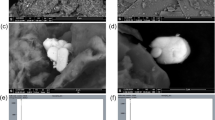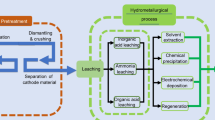Abstract
The article confirms the possibility of using a two-component iron-phosphate glass composite material synthesized at 700 °C to immobilize a simulator of a highly-active spent chloride electrolyte, such as those obtained in the pyrochemical processing of the spent mixed uranium-plutonium fuel of a BREST-OD-300 reactor. The structure and phase composition of the material were studied using scanning electron microscopy with energy-dispersion X‑ray spectroscopy, X‑ray fluorescence analysis, and X-ray powder diffractometry. The waste components are shown to form stable pyrophosphate phases. The material leachability of waste components is defined according to the PCT standard. The glass composite material is highly water resistant. Thus, the prospects for the practical application of the studied material for the reliable immobilization of spent electrolyte materials are demonstrated.



Similar content being viewed by others
References
Jantzen, C., Lee, W., Ojovan, M.: Radioactive waste (raw) conditioning, immobilization, and encapsulation processes and technologies: overview and advances. In: Radioactive Waste Management and Contaminated Site Clean-Up, pp. 171–272. Woodhead Publishing, Cambridge (2013)
Donald, I.: Waste immobilization in glass and ceramic based hosts: radioactive, toxic and hazardous wastes. Wiley-Blackwell, USA (2010)
Gregg, D., Farzana, R., Dayal, P.: Synroc technology. Perspectives and current status. J Am Ceram Soc 103(10), 5424–5441 (2020)
McCloy, J., Schuller, S.: Vitrification of wastes: from unwanted to controlled crystallization, a review. Comp Rendus Geosci 354(S1), 121–160 (2022)
Juoi, J., Ojovan, M., Lee, W.: Microstructure and leaching durability of glass composite wasteforms for spent clinoptilolite immobilization. J Nucl Mater 372(2–3), 358–366 (2008)
Donald, I., Metcalfe, B., Fong, S.: A glass-encapsulated calcium phosphate wasteform for the immobilization of actinide-, fluoride-, and chloride-containing radioactive wastes from the pyrochemical reprocessing of plutonium metal. J Nucl Mater 361(1), 78–93 (2007)
Lavrynovych, Y.G., Kormilitsyn, M.V., Konovalov, V.I.: Vitrification of chloride waste from the pyroelectrochemical method of processing irradiated nuclear fuel. Atomnaya Energiya 95(5), 367–372 (2003)
Kulikova, S.A., Danilov, S.S., Matveenko, A.V.: Perspective compounds for immobilization of spent electrolyte from pyrochemical processing of spent nuclear fuel. Appl Sci 11(23), 11180 (2021)
Brow, R.: Review: the structure of simple phosphate glasses. J Non Cryst Solids 263–264, 1–28 (2000)
Frolova, A.V., Vinokurov, S.E., Gromyak, I.N., Danilov, S.S.: Medium-temperature phosphate glass composite material as a matrix for the immobilization of high-level waste containing volatile radionuclides. Energies 15(20), 7506 (2022)
Vance, E., Davis, J., Olufsan, K.: Candidate waste forms for immobilisation of waste chloride salt from pyroprocessing of spent nuclear fuel. J Nucl Mater 420(1–3), 396–404 (2012)
Standard Test Methods for Determining Chemical Durability of Nuclear: Hazardous, and mixed waste glasses and Multiphase glass ceramics. The Product Consistency Test (PCT). ASTM Intern, West Conshohocken (2002)
Yang, J., Park, H., Cho, Y.: Al2O3-containing silver phosphate glasses as hosting matrices for radioactive iodine. J Nucl Sci Technol 54(12), 1330–1337 (2017)
Park, H., Cho, I., Eun, H.: Characteristics of wasteform composing of phosphate and silicate to immobilize radioactive waste salts. Environ. Sci. Technol. 45(5), 1932–1939 (2011)
Funding
The study was carried out at the expense of the grant of the Russian Science Foundation No. 22-29-01523 (https://rscf.ru/project/22-29-01523/).
Author information
Authors and Affiliations
Corresponding author
Additional information
Translated from Atomnaya Energiya, Vol. 134, No. 5–6, pp. 246–249, May–June, 2023.
Publisher’s Note
Springer Nature remains neutral with regard to jurisdictional claims in published maps and institutional affiliations.
Original article submitted June 30, 2023.
Rights and permissions
Springer Nature or its licensor (e.g. a society or other partner) holds exclusive rights to this article under a publishing agreement with the author(s) or other rightsholder(s); author self-archiving of the accepted manuscript version of this article is solely governed by the terms of such publishing agreement and applicable law.
About this article
Cite this article
Frolova, A.V., Fimina, S.A. & Vinokurov, S.E. Immobilization of chloride radioactive waste using a phosphate glass composite material. At Energy (2024). https://doi.org/10.1007/s10512-024-01062-2
Published:
DOI: https://doi.org/10.1007/s10512-024-01062-2




